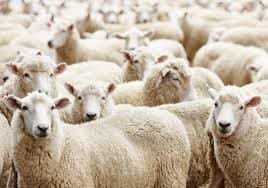INTERNATIONAL mills are closed and wool is being stockpiled across the Central West with COVID-19 dramatically impacting the market.
The drought was hard enough, but a worldwide pandemic was something producers and buyers could never plan for.
While the big mills in China are still taking wool, mills in Italy, Europe, India and Korea are taking very little, with bales of wool now being stockpiled across NSW.
“If we didn’t have China we’d be stuffed … China buys 75 per cent of wool clip from Australia,” Central West wool broker David Walsh said.
In a good season 75 per cent of a bale is wool while the rest is dirt and burrs, but right now he said many bales are down to around to just 50 per cent wool.
“They’ve [buyers] pulled their price back because they’re getting inferior wool and that’s been happening for 12 months,” Mr Walsh said.
“Then COVID came in and some of the countries that were buying from Australia stopped.
“Because of COVID and the drought, there’s no competition so people aren’t buying.”
“If we didn’t have China we’d be stuffed.” Central West wool broker David Walsh
Wool producer Geoff Rayner runs Pomanara Merino Stud, located midway between Bathurst and Mudgee, and he’s worried as wool prices have fallen to a five-year low.
“COVID is effecting the Europeans and a lot of retailers have gone broke or shut down and then a lot of retail shops in Europe also have retail shops in the US,” he said.
“The mills don’t need the workers to process and then, the scary thing for us, is they don’t need our wool.”
Mr Rayner said lower wool quality due to the drought has helped to drop prices and some producers have turned to selling sheep instead.
“They’re making enough money out of selling their old sheep so they’re just letting the wool sit there. The mutton and lamb trade is doing well,” he said.
“When it gets better then everyone will sell and there will be a glut of wool on the market.”
Jamalong Wool’s Rowan Woods said some people are not willing to accept the current market prices and are holding onto their wool.
“Some are holding on because they think there is more downturn to come and others are selling because they need the cashflow,” he said.
Jemalong is a wool handling and marketing organisation in Forbes, Tamworth and Cooma and they have gone from selling an average of 1500 to 2000 bales a week down to 250-500.
“This is very hard on wool producers but it’s also very hard on wool handlers because we don’t get paid until we sell the wool,” Mr Woods said.
“We’re coming straight out of the worst drought in recorded history and we’ve got COVID and we’re still having heavily drought effected wool.”
Australian wool markets are currently on a three-week recess until early August and Mr Woods fears there will be an over supply on the market when sales return.

